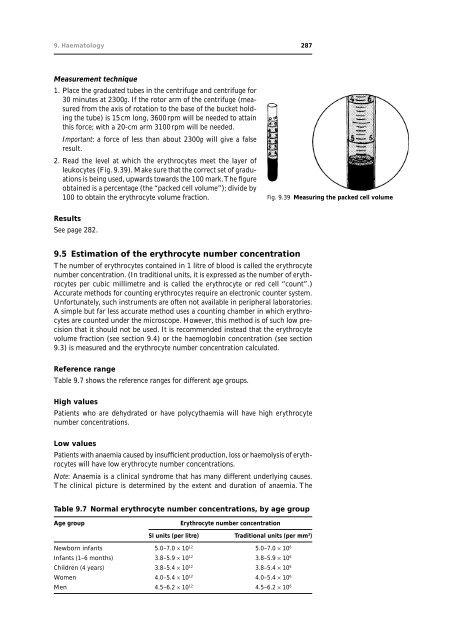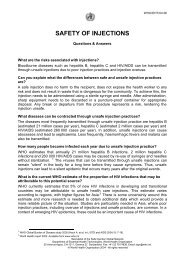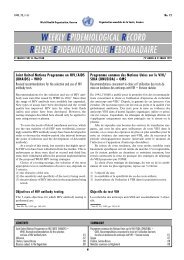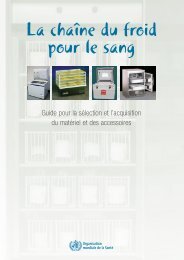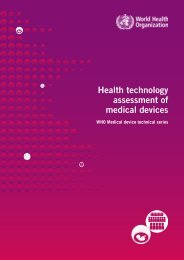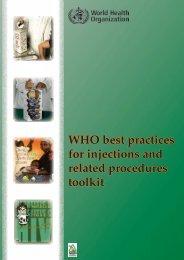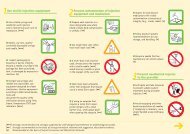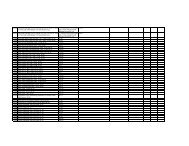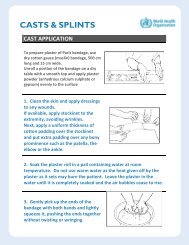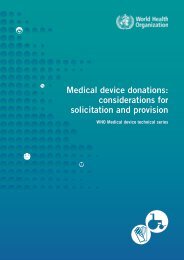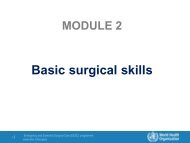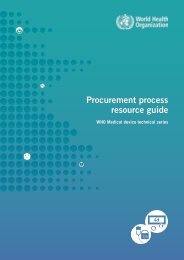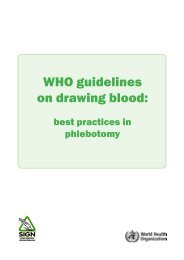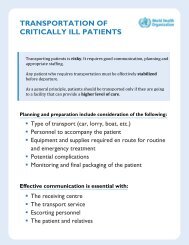- Page 1 and 2:
M A N U A L O F B A S I C TECHNIQUE
- Page 3 and 4:
Contents i Manual of basic techniqu
- Page 5 and 6:
Contents iii Contents Preface x 1.
- Page 7 and 8:
Contents v 4.2.1 Collection of spec
- Page 9 and 10:
Contents vii PART III 231 7. Examin
- Page 11 and 12:
Contents ix 10.1.3 Method 322 10.1.
- Page 13 and 14:
1. Introduction 1 1. Introduction 1
- Page 15 and 16:
1. Introduction 3 The following sec
- Page 17 and 18:
1. Introduction 5 Table 1.4 SI deri
- Page 19 and 20:
1. Introduction 7 Table 1.5 (cont.)
- Page 21 and 22:
2. Setting up a peripheral health l
- Page 23 and 24:
2. Setting up a peripheral health l
- Page 25 and 26:
2. Setting up a peripheral health l
- Page 27 and 28:
2. Setting up a peripheral health l
- Page 29 and 30:
2. Setting up a peripheral health l
- Page 31 and 32:
2. Setting up a peripheral health l
- Page 33 and 34:
2. Setting up a peripheral health l
- Page 35 and 36:
2. Setting up a peripheral health l
- Page 37 and 38:
2. Setting up a peripheral health l
- Page 39 and 40:
2. Setting up a peripheral health l
- Page 41 and 42:
2. Setting up a peripheral health l
- Page 43 and 44:
2. Setting up a peripheral health l
- Page 45 and 46:
2. Setting up a peripheral health l
- Page 47 and 48:
2. Setting up a peripheral health l
- Page 49 and 50:
2. Setting up a peripheral health l
- Page 51 and 52:
2. Setting up a peripheral health l
- Page 53 and 54:
2. Setting up a peripheral health l
- Page 55 and 56:
2. Setting up a peripheral health l
- Page 57 and 58:
2. Setting up a peripheral health l
- Page 59 and 60:
2. Setting up a peripheral health l
- Page 61 and 62:
2. Setting up a peripheral health l
- Page 63 and 64:
2. Setting up a peripheral health l
- Page 65 and 66:
3. General laboratory procedures 53
- Page 67 and 68:
3. General laboratory procedures 55
- Page 69 and 70:
3. General laboratory procedures 57
- Page 71 and 72:
3. General laboratory procedures 59
- Page 73 and 74:
3. General laboratory procedures 61
- Page 75 and 76:
3. General laboratory procedures 63
- Page 77 and 78:
3. General laboratory procedures 65
- Page 79 and 80:
3. General laboratory procedures 67
- Page 81 and 82:
3. General laboratory procedures 69
- Page 83 and 84:
3. General laboratory procedures 71
- Page 85 and 86:
3. General laboratory procedures 73
- Page 87 and 88:
3. General laboratory procedures 75
- Page 89 and 90:
3. General laboratory procedures 77
- Page 91 and 92:
3. General laboratory procedures 79
- Page 93 and 94:
3. General laboratory procedures 81
- Page 95 and 96:
3. General laboratory procedures 83
- Page 97 and 98:
3. General laboratory procedures 85
- Page 99 and 100:
3. General laboratory procedures 87
- Page 101 and 102:
3. General laboratory procedures 89
- Page 103 and 104:
3. General laboratory procedures 91
- Page 105 and 106:
3. General laboratory procedures 93
- Page 107 and 108:
3. General laboratory procedures 95
- Page 109 and 110:
3. General laboratory procedures 97
- Page 111 and 112:
3. General laboratory procedures 99
- Page 113 and 114:
3. General laboratory procedures 10
- Page 115 and 116:
4. Parasitology 103 Part II
- Page 117 and 118:
4. Parasitology 105 4.Parasitology
- Page 119 and 120:
4. Parasitology 107 4.2 Examination
- Page 121 and 122:
4. Parasitology 109 colourless, red
- Page 123 and 124:
4. Parasitology 111 Table 4.3 Patho
- Page 125 and 126:
4. Parasitology 113 Fig. 4.13 Invas
- Page 127 and 128:
4. Parasitology 115 Motility: eithe
- Page 129 and 130:
4. Parasitology 117 Rapid Field sta
- Page 131 and 132:
4. Parasitology 119 Fig. 4.24 Featu
- Page 133 and 134:
4. Parasitology 121 Identification
- Page 135 and 136:
4. Parasitology 123 Measurement Acc
- Page 137 and 138:
4. Parasitology 125 Shape: round or
- Page 139 and 140:
4. Parasitology 127 ● ● ● The
- Page 141 and 142:
4. Parasitology 129 Fig. 4.39 Terms
- Page 143 and 144:
4. Parasitology 131
- Page 145 and 146:
4. Parasitology 133 Fig. 4.42 Ancyl
- Page 147 and 148:
4. Parasitology 135 Dipylidium cani
- Page 149 and 150:
4. Parasitology 137 Fig. 4.59 Trans
- Page 151 and 152:
4. Parasitology 139 Fig. 4.66 Heter
- Page 153 and 154:
4. Parasitology 141 Shell: smooth,
- Page 155 and 156:
4. Parasitology 143 Fig. 4.79 Filli
- Page 157 and 158:
4. Parasitology 145 These granules
- Page 159 and 160:
4. Parasitology 147 Fig. 4.92 Adult
- Page 161 and 162:
4. Parasitology 149 Fig. 4.97 Featu
- Page 163 and 164:
4. Parasitology 151 Fig. 4.101 Schi
- Page 165 and 166:
4. Parasitology 153 Method Preparat
- Page 167 and 168:
4. Parasitology 155 2. Using the sp
- Page 169 and 170:
4. Parasitology 157 differentiated
- Page 171 and 172:
4. Parasitology 159 5. Add to the t
- Page 173 and 174:
4. Parasitology 161 Method Collecti
- Page 175 and 176:
4. Parasitology 163 Procedure for o
- Page 177 and 178:
4. Parasitology 165 Table 4.8 Chara
- Page 179 and 180:
4. Parasitology 167 Method 1. Colle
- Page 181 and 182:
4. Parasitology 169 7. Remove the s
- Page 183 and 184:
4. Parasitology 171 Cephalic space
- Page 185 and 186:
4. Parasitology 173 Table 4.10 Geog
- Page 187 and 188:
4. Parasitology 175 Fig. 4.132 Coll
- Page 189 and 190:
4. Parasitology 177 1. Allow the th
- Page 191 and 192:
4. Parasitology 179 Table 4.11 Comp
- Page 193 and 194:
4. Parasitology 181 Table 4.12 (con
- Page 195 and 196:
4. Parasitology 183 African trypano
- Page 197 and 198:
4. Parasitology 185 Fig. 4.144 Twis
- Page 199 and 200:
4. Parasitology 187 Fig. 4.150 Usin
- Page 201 and 202:
4. Parasitology 189 The above mater
- Page 203 and 204:
4. Parasitology 191 Fig. 4.158 Appl
- Page 205 and 206:
4. Parasitology 193 clinical sympto
- Page 207 and 208:
4. Parasitology 195 Examination of
- Page 209 and 210:
5. Bacteriology 197 5. Bacteriology
- Page 211 and 212:
5. Bacteriology 199 5.2.4 Fixation
- Page 213 and 214:
5. Bacteriology 201 Fig. 5.14 “Ac
- Page 215 and 216:
5. Bacteriology 203 Table 5.2 Repor
- Page 217 and 218:
5. Bacteriology 205 ● Parasites:
- Page 219 and 220:
5. Bacteriology 207 Throat specimen
- Page 221 and 222:
5. Bacteriology 209 Other bacteria
- Page 223 and 224:
5. Bacteriology 211 5.6.3 Microscop
- Page 225 and 226:
5. Bacteriology 213 Fig. 5.28 Sperm
- Page 227 and 228:
5. Bacteriology 215 3. Load an impr
- Page 229 and 230:
5. Bacteriology 217 Fig. 5.34 Vibri
- Page 231 and 232:
5. Bacteriology 219 2. Remove the s
- Page 233 and 234:
5. Bacteriology 221 5.12.2 Method C
- Page 235 and 236:
5. Bacteriology 223 Fig. 5.43 Trans
- Page 237 and 238:
6. Mycology 1 6.1 Examination of sk
- Page 239 and 240:
6. Mycology 227 6.2.1 Materials and
- Page 241:
6. Mycology 229 Fig. 6.8 Transferri
- Page 244 and 245:
232 Manual of basic techniques for
- Page 246 and 247:
234 Manual of basic techniques for
- Page 248 and 249: 236 Manual of basic techniques for
- Page 250 and 251: 238 Manual of basic techniques for
- Page 252 and 253: 240 Manual of basic techniques for
- Page 254 and 255: 242 Manual of basic techniques for
- Page 256 and 257: 244 Manual of basic techniques for
- Page 258 and 259: 246 Manual of basic techniques for
- Page 260 and 261: 248 Manual of basic techniques for
- Page 262 and 263: 250 Manual of basic techniques for
- Page 264 and 265: 252 Manual of basic techniques for
- Page 266 and 267: 254 Manual of basic techniques for
- Page 268 and 269: 256 Manual of basic techniques for
- Page 270 and 271: 258 Manual of basic techniques for
- Page 272 and 273: 260 Manual of basic techniques for
- Page 274 and 275: 262 Manual of basic techniques for
- Page 276 and 277: 264 Manual of basic techniques for
- Page 278 and 279: 266 Manual of basic techniques for
- Page 280 and 281: 268 Manual of basic techniques for
- Page 282 and 283: 270 Manual of basic techniques for
- Page 284 and 285: 272 Manual of basic techniques for
- Page 286 and 287: 274 Manual of basic techniques for
- Page 288 and 289: 276 Manual of basic techniques for
- Page 290 and 291: 278 Manual of basic techniques for
- Page 292 and 293: 280 Manual of basic techniques for
- Page 294 and 295: 282 Manual of basic techniques for
- Page 296 and 297: 284 Manual of basic techniques for
- Page 300 and 301: 288 Manual of basic techniques for
- Page 302 and 303: 290 Manual of basic techniques for
- Page 304 and 305: 292 Manual of basic techniques for
- Page 306 and 307: 294 Manual of basic techniques for
- Page 308 and 309: 296 Manual of basic techniques for
- Page 310 and 311: 298 Manual of basic techniques for
- Page 312 and 313: 300 Manual of basic techniques for
- Page 314 and 315: 302 Manual of basic techniques for
- Page 316 and 317: 304 Manual of basic techniques for
- Page 318 and 319: 306 Manual of basic techniques for
- Page 320 and 321: 308 Manual of basic techniques for
- Page 322 and 323: 310 Manual of basic techniques for
- Page 324 and 325: 312 Manual of basic techniques for
- Page 326 and 327: 314 Manual of basic techniques for
- Page 328 and 329: 316 Manual of basic techniques for
- Page 330 and 331: 318 Manual of basic techniques for
- Page 332 and 333: 320 Manual of basic techniques for
- Page 334 and 335: 10. Blood chemistry 10.1 Estimation
- Page 336 and 337: 324 Manual of basic techniques for
- Page 338 and 339: 326 Manual of basic techniques for
- Page 340 and 341: 11. Immunological and serological t
- Page 342 and 343: 330 Manual of basic techniques for
- Page 344 and 345: 332 Manual of basic techniques for
- Page 346 and 347: 334 Manual of basic techniques for
- Page 348 and 349:
336 Manual of basic techniques for
- Page 350 and 351:
338 Manual of basic techniques for
- Page 352 and 353:
340 Manual of basic techniques for
- Page 354 and 355:
342 Manual of basic techniques for
- Page 356 and 357:
344 Manual of basic techniques for
- Page 358 and 359:
346 Manual of basic techniques for
- Page 360 and 361:
348 Manual of basic techniques for
- Page 362 and 363:
350 Manual of basic techniques for
- Page 364 and 365:
352 Manual of basic techniques for
- Page 366 and 367:
354 Manual of basic techniques for
- Page 368 and 369:
356 Manual of basic techniques for
- Page 370 and 371:
358 Manual of basic techniques for
- Page 372 and 373:
360 Manual of basic techniques for
- Page 374 and 375:
362 Manual of basic techniques for
- Page 376 and 377:
364 Manual of basic techniques for
- Page 378 and 379:
366 Manual of basic techniques for
- Page 380 and 381:
368 Manual of basic techniques for
- Page 382 and 383:
370 Index BI, see Bacteriological i
- Page 384 and 385:
372 Index Dark-field microscopy 64,
- Page 386 and 387:
374 Index Formaldehyde-ether sedime
- Page 388 and 389:
376 Index Labelling (continued) spe
- Page 390 and 391:
378 Index Open two-pan balances 67-
- Page 392 and 393:
380 Index Reference ranges (continu
- Page 394 and 395:
382 Index Strongyloides stercoralis
- Page 396 and 397:
384 Index Venous blood collection 2
- Page 398:
This manual provides a practical gu


